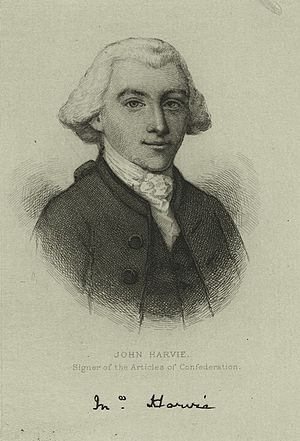John Harvie facts for kids
Quick facts for kids
John Harvie
|
|
|---|---|

Albert Rosenthal etching of Harvie
|
|
| Secretary of the Commonwealth of Virginia | |
| In office 1788–1789 |
|
| Mayor of Richmond, Virginia | |
| In office 1785–1786 |
|
| Preceded by | Robert Mitchell |
| Succeeded by | William Pennock |
| Delegate to the Continental Congress | |
| In office 1777–1778 |
|
| Member of the Virginia conventions | |
| In office 1775–1776 |
|
| Personal details | |
| Born | 1742 Albemarle County, Virginia |
| Died | February 6, 1807 (age 64 or 65) Richmond, Virginia |
| Profession | Lawyer, Statesman |
John Harvie (1742 – February 6, 1807) was an important American leader from Virginia. He was a lawyer and a builder. Harvie was a delegate to the Second Continental Congress, a group of leaders who helped create the United States. He even signed the Articles of Confederation, which was like the first constitution of the U.S.
John Harvie was a successful lawyer and owned a lot of land. He also served as the fourth mayor of Richmond, Virginia. He was a close friend of Thomas Jefferson since childhood. Harvie helped make a peace treaty in 1774 after the Battle of Point Pleasant. During the American Revolutionary War, he worked on the Board of War. He also ran a prison camp for soldiers on his property called The Barracks.
Contents
Early Life and Family
John Harvie was born in 1742 at Belmont Plantation. This was in Albemarle County, Virginia. His parents were John Harvie Sr., who came from Scotland, and Martha Gaines Harvie. John was good friends with Thomas Jefferson. His father was even Jefferson's legal guardian after Jefferson's own father died.
In 1767, John Harvie inherited Belmont Plantation. He later married Margaret Morton Jones. They had four sons: Lewis, John, Edwin, and Jacquelin. They also had three daughters: Gabriella, Emily, and Julia. Harvie lived at Belmont until 1780. Then, he moved to Richmond.
Harvie's Career
John Harvie was very skilled in business and finance. He earned a lot of money in Richmond and across Virginia.
Law and Business
Harvie was one of the first directors of the Bank of Virginia. He helped set up the bank's capital, which is the money it uses to operate. He also built a very successful law practice. He was one of the first lawyers to work at the Albemarle bar, which is where legal cases were heard.
Political Roles
John Harvie played a big part in Virginia's government. When Governor Dunmore closed the House of Burgesses, Harvie was chosen to represent West Augusta County. He served in the Virginia revolutionary conventions in 1775 and 1776. These meetings were important steps toward independence.
The next year, other leaders chose Harvie to be a delegate for Virginia. He went to the Second Continental Congress. While there, he was one of five delegates from Virginia to sign the Articles of Confederation. This happened on July 9, 1778. The Articles were the first agreement that united the 13 American colonies.
In 1780, Harvie became the registrar of the Land Office. This job meant he was in charge of land deals. His office handled land in the Northwest Territory, which included parts of western Virginia, Ohio, and Kentucky. From 1785 to 1786, John Harvie served as the mayor of Richmond.
Military Service
In 1774, Harvie was chosen to help make a peace treaty. He worked with the Shawnee Tribe after the Battle of Point Pleasant. He was also a colonel in the Virginia militia in 1776. Harvie and Thomas Walker were given special powers to talk with Native American tribes at Fort Pitt.
During the American Revolutionary War, Colonel Harvie helped get supplies for Virginia's militia. He also helped the Continental Army. He was part of the Board of War. This group helped manage the war effort. Harvie visited Valley Forge to see the difficult conditions there. He supported General George Washington during a tough time.
Harvie also helped set up a prison camp called The Barracks. This camp held about 6,000 Hessian and British soldiers. Harvie bought the 240-acre property in 1778. It was located west of Charlottesville. The camp had brick buildings for the troops. It also had gardens and farm animals. Some soldiers escaped and settled in the mountains. The remaining soldiers were moved north in November 1780.
| The Barracks | |
|---|---|
| Town/City | Barracks Farm Road, Charlottesville West |
| State | Virginia |
| Country | United States |
| Coordinates | 38°5′48.49″N 78°30′59.05″W / 38.0968028°N 78.5164028°W |
| Established | By 1778 |
| Area | 240 acres |
Land Owner and Developer
John Harvie owned many large properties. These included Belmont, Pen Park, and The Barracks. In 1798, he bought the Belvidere estate in Richmond. This estate was known for its beautiful house and architecture.
Death and Lasting Impact
John Harvie died on February 6, 1807. He was inspecting a new mansion being built when he fell from the roof. He was buried at the family plot at Belvidere. This property later became part of the Hollywood Cemetery in Richmond. His wife, Margaret, inherited the Belvidere estate. She lived there until 1814, when she sold it.
A street in Richmond, Harvie Street, is named after him. It runs between Park Avenue and Cary Street. Jacquelin Street is thought to be named after his son, General Jacquelin Harvie.


